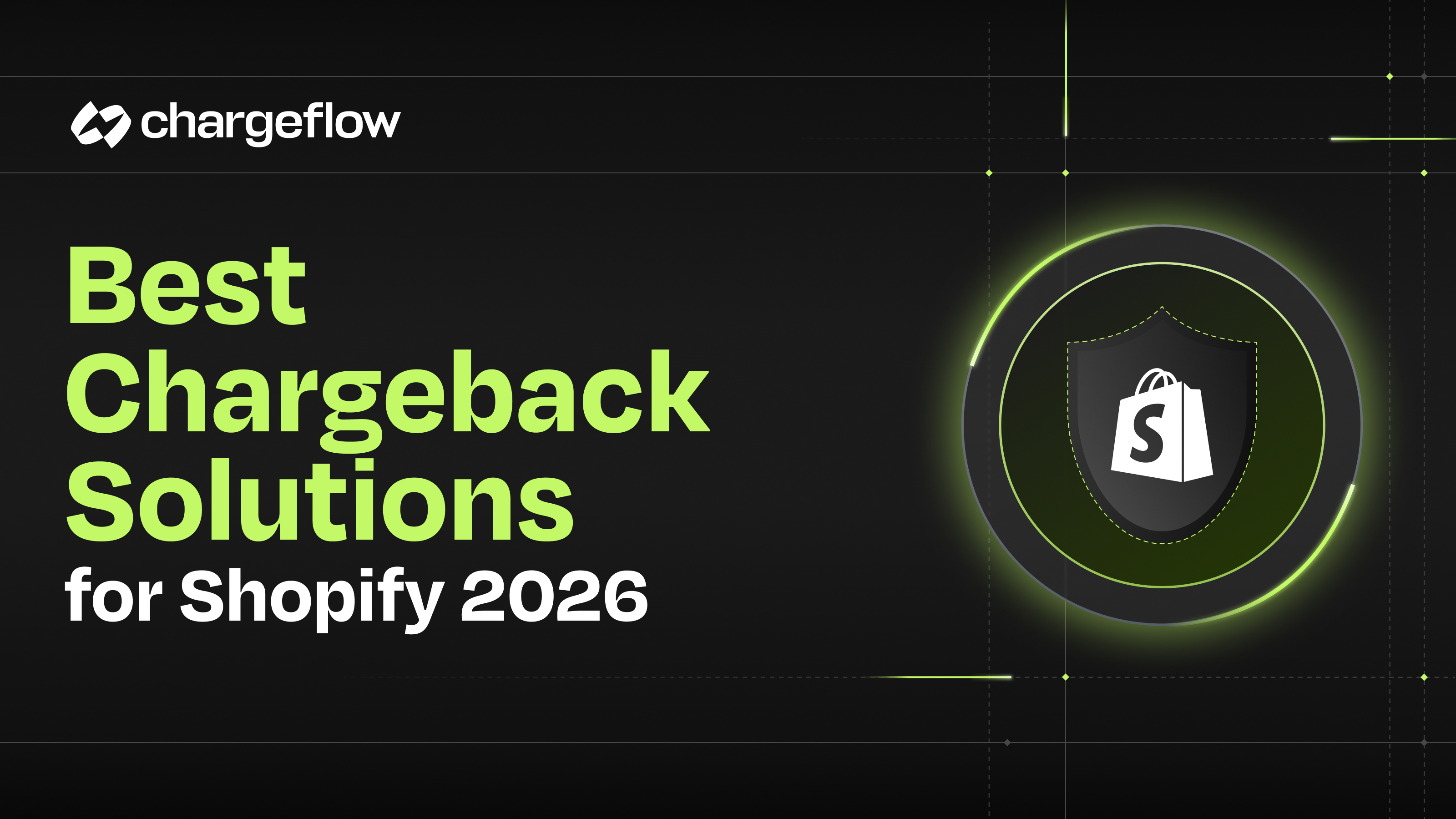The Ultimate Chargeback Prevention Guide

Chargebacks?
No longer your problem.
Recover 4x more chargebacks and prevent up to 90% of incoming ones, powered by AI and a global network of 15,000 merchants.
This comprehensive guide covers everything from understanding chargeback fraud to implementing effective prevention techniques.
Online businesses are witnessing changes right before their eyes as online commerce evolves. The biggest challenge they’re facing though hands down are chargebacks. This trend is a serious threat to every businesses financial stability and growth. In 2022, losses due to online payment fraud reached $41 billion in the eCommerce sector, that’s not all, this number is expected to rise to a staggering $48 billion in 2023. But wait there’s more – chargeback fraud alone is rising and costing merchants over $100 billion. This growing issue enforces the critical need for effective management and prevention strategies when it comes to the digital commerce landscape.
This guide aims to offer a comprehensive roadmap to effectively mitigate chargeback risks, empowering businesses to bolster their defenses against this rising wave of fraud and disputes, ensuring their longevity and success in the fast-paced digital marketplace.
What Are Chargebacks?
Let's start by defining what a chargeback is. A chargeback occurs when a customer disputes a credit card transaction and the amount charged is reversed from the merchant back to the customer's account. Initially established as a consumer protection mechanism, chargebacks are designed to safeguard customers against unauthorized or fraudulent transactions.
The Chargeback Process in E-Commerce
The chargeback process begins when as soon as a customer files a dispute with their bank or card issuer, reason are provided such as non-receipt of goods, dissatisfaction with the product or service, or an unauthorized charge. The bank then reviews the dispute, and if the claim is valid, it reverses the charge and deducts the amount from the merchant and credits it back to the customer.
The Dual Role of Chargebacks
It's true that chargebacks can play a vital role in protecting consumer rights in online transactions, they can alsopresent significant challenges for businesses. The issue here is this can lead to direct financial losses, resource allocation for dispute resolution, and it can potentially harm the merchant's reputation among payment processors.
Understanding Chargeback Fraud
Chargeback fraud, also known as friendly fraud, is when a cardholder makes an online transaction with their credit card and then files a chargeback with the issuing bank after receiving the purchased goods or services.
Such fraudsters falsely complain they didn't receive their purchase order, that it wasn't what they expected to receive, that they did not authorize the transaction, or that they had requested a cancellation of recurring transactions and the seller billed them anyway. However, none of these reasons are usually genuine. The crux of chargeback fraud is the consumer's intent to exploit the system for personal gain, essentially seeking to receive goods or services without paying.
How serious is chargeback fraud?
Chargeback fraud presents a significant business sustainability risk to merchants. It creates a damaging cycle for merchants, impacting their financial health and relationship with banks and payment processors.
Banks don't have time to ascertain the merit of every cardholder dispute before granting such chargebacks. Merchants often write off chargebacks as the cost of doing business (due to the uphill battle of fighting fraudulent disputes). Consequently, banks are not eager to adopt policies and instruments that deter con artists from weaponizing the chargeback process. Banks see merchants' ignoring chargebacks as a total admission of guilt, making them eager to side with cardholders.
In the end, when merchants don’t keep their chargeback rates under the established chargeback limit, card networks place them in fraud or dispute monitoring programs. That brings underlying issues like excessive processing fees, reputational risks, and ultimately loss of payment processing rights – which is often a nail in the coffin for the business.
Types of Chargeback Fraud
- Criminal Fraud: This refers to the unauthorized use of stolen credit card information. The legitimate cardholder, upon discovering an unauthorized transaction, files for a chargeback and is often unaware of the fraudulent transaction until it appears on their statement.
- Friendly Fraud: Despite its seemingly harmless name, friendly fraud is deceptive and harmful. It occurs when a customer makes a legitimate purchase and then disputes the transaction with false claims, such as the product or service not being delivered, or the transaction being unauthorized.
- Merchant Errors: Not all chargebacks stem from intentional fraud. Some result from merchant errors like accidental overcharging, billing for undelivered services, or misrepresenting products. While these are honest mistakes, they still result in chargebacks and need efficient management.
.jpeg)
How to Prevent Chargeback Frauds?
According to a Kount report, businesses face significant hurdles in chargeback prevention. A notable 32% of respondents cite a lack of experience with chargeback prevention as their top challenge, while 22% struggle due to a lack of robust prevention strategies. Additionally, 17% report that insufficient resources for disputing chargebacks pose a major issue. These statistics underscore the complexities businesses encounter in managing chargebacks effectively.
The challenges in chargeback prevention, highlighted by the experiences of many businesses, underline the necessity for targeted and effective strategies. Let's delve into the methods to proactively safeguard against various types of chargebacks.
Prevent Criminal Fraud Chargebacks with a Multi-layer Fraud Mitigation Protocol
To combat criminal fraud chargebacks effectively, a multilayer approach is essential. Utilize several complementary fraud detection mechanisms for a detailed analysis of each transaction. Implement fraud scoring tools to assess every transaction and categorize them based on potential fraud risk. This allows for more precise manual review or automatic rejection of high-risk purchases.
Prevent Friendly Fraud by Stopping Transaction Dispute Triggers
Acknowledging the complexity of stopping friendly fraud chargebacks, it's vital to focus on preemptive measures. Prioritize eliminating internal errors and criminal fraud triggers that could lead to chargebacks. By refining your transaction processes, you enhance your readiness to confront friendly fraud chargebacks, demonstrating your business's resilience against fraudulent activities.
Prevent Merchant Error Chargeback by Optimizing Your Systems
To minimize merchant error chargebacks, conduct a thorough review of your order processing, customer journey, and compliance protocols. Identifying and rectifying procedural errors and inefficiencies in your systems can significantly reduce the occurrence of these chargebacks. This proactive review ensures a smoother, more reliable customer experience
The True Cost of Chargebacks
Understanding the comprehensive impact of chargebacks is crucial for businesses. This involves examining both tangible and intangible impacts on businesses.
Tangible Costs
- Direct Financial Losses: Including the refunded transaction amount, chargeback fees ranging from $15 to $100 for card networks and can range from $10 to over $500.for payment processors), investigation fees, and fines for excessive chargebacks.
- Operational Costs: Covering resource allocation for managing chargebacks, compliance and legal expenses, and additional fees depending on the transaction's card type.
- Loss of Goods or Services: In cases where the product or service cannot be reclaimed, businesses suffer a loss in inventory or service provision.
Intangible Costs
- Reputational Damage: Frequent chargebacks may indicate poor customer service or product quality, negatively impacting brand perception and jeopardizing relationships with payment processors and banks, potentially leading to increased fees or account termination.
- Operational Disruption: Handling chargebacks demands significant administrative effort, diverting resources from primary business activities and requiring additional focus on tracking and responding to trends, affecting overall productivity.
- Strategic Impact: High chargeback rates compromise market competitiveness and disrupt long-term financial planning, making it challenging to maintain a competitive edge and predict financial outcomes effectively.
By understanding these varied impacts, businesses can develop more effective strategies for chargeback management, focusing on both prevention and efficient resolution to minimize immediate financial losses and safeguard long-term business stability.
10 Chargeback Prevention Strategies
To effectively prevent and manage chargebacks, businesses can implement the following key strategies:
- Enhanced Chargeback Management through Automation: Utilizing tools like Chargeflow for automating chargeback processes can significantly reduce revenue loss and streamline dispute management. Chargeback-related revenue loss decreased from 7.79% to 2.31% between 2017 and 2021, demonstrating the effectiveness of automation in reducing chargebacks and improving operational efficiency.
- Chargeback Alerts and Notifications: Utilizing alert services for early detection of filed chargebacks allows businesses to take preemptive action.
- Rigorous Record Keeping: Maintaining detailed records of transactions, customer communications, and delivery information is essential. This data is critical for disputing chargebacks effectively.
- Data-Driven Analysis of Chargeback Reasons: Analyze chargeback reason codes to understand underlying causes and tailor prevention strategies.
- Machine Learning for Predictive Risk Management: Use advanced algorithms to predict high-risk transactions and proactively mitigate chargeback risks.
- Integration with Payment Processors and Banks: Seamlessly integrate chargeback management tools with payment processors and banking systems for streamlined operations.
- AVS and CVV Security Measures: Implement Address Verification System (AVS) and Card Verification Value (CVV) checks to verify transaction authenticity and reduce fraud.
- Addressing Transaction Dispute Triggers and Preventing Friendly Fraud: Identify and tackle common causes behind friendly fraud, such as improving post-purchase communication to minimize misunderstandings.
- Clear and Detailed Product Descriptions: Providing accurate and comprehensive product information is key to preventing disputes arising from customer confusion or unmet expectations.
- Proactive Refund Policies: Implementing a clear, fair, and easily accessible refund policy. Encouraging customers to opt for refunds rather than disputing charges.
The Evolution of Anti-Fraud Technologies in Chargeback Prevention
The online commerce landscape has been reshaped by the evolution of anti-fraud technologies, providing sophisticated tools for managing chargebacks. Key advancements include:
- Integration of AI and Machine Learning: Powers algorithms for real-time transaction analysis, like the functionality seen in Chargeflow Alerts. and predictive analytics which helps predict the likelihood of fraud in transactions.
- Real-Time Detection: AI's immediate processing capabilities allow swift identification of fraudulent transactions.
- Adaptive Learning: AI and ML systems adjust to new fraud methods, maintaining defense against evolving threats.
- Minimizing False Positives: Improved accuracy in distinguishing legitimate from fraudulent transactions.
These technologies have significantly enhanced the effectiveness of chargeback prevention strategies, making them indispensable in the modern digital marketplace.
The Role of Fraud Scoring and Real-Time Analytics
- Risk Assessment: AI-driven fraud scoring assigns risk levels to transactions based on multiple factors. This risk assessment is more dynamic and sensitive to subtle indicators of fraud.
- Immediate Insights: Real-time analytics, a cornerstone of modern anti-fraud technologies, provide instant analysis of transaction data. This immediacy is essential for swift action against suspected fraud, safeguarding both the business and its customers.
Analyzing Chargeback Sources
Understanding the root causes of chargebacks is critical for any business engaged in online transactions. An in-depth analysis of these sources is necessary to develop effective strategies for prevention and management.
Importance of Detailed Reporting and Analytics
- Pinpointing Trends and Sources: Utilizing detailed reporting and analytics is key in identifying patterns and trends that lead to chargebacks. By closely examining transaction data, businesses can uncover common denominators in chargebacks, such as specific transaction types, customer demographics, or time frames.
- Root Cause Analysis: Analyzing chargeback sources goes beyond surface-level data. It involves digging into the transaction lifecycle to understand why chargebacks are occurring. This could include factors like customer dissatisfaction, product issues, or even procedural errors in processing transactions.
- Strategy Development: Armed with this information, businesses can tailor their chargeback prevention strategies more effectively, addressing the specific issues that contribute to their unique chargeback landscape.
Chargeflow's Approach
Chargeflow stands as a comprehensive solution for chargeback prevention and management, aligning closely with the strategies discussed for analyzing and reducing chargebacks. Let’s discuss some of their features and capabilities.
Features and Capabilities of Chargeflow
- Automated Dispute Management: Chargeflow automates the dispute management process, reducing the manual effort and increasing the efficiency of responding to chargebacks. This automation is key in managing high volumes of transactions and minimizing human error.

- Data-Driven Insights: Chargeflow offers detailed reporting and analytics features that provide businesses with critical insights into their chargeback sources. This data-driven approach enables companies to make informed decisions and implement targeted prevention strategies.
- Integration with Fraud Prevention Tools: Chargeflow integrates seamlessly with existing fraud prevention tools, enhancing their effectiveness. This integration ensures that businesses are not only reacting to chargebacks but also proactively preventing them.
- Chargeflow Alerts: A pivotal feature, Chargeflow Alerts offers real-time notifications about chargeback threats. This prompt alert system allows businesses to act swiftly, addressing potential issues before they escalate into chargebacks. These alerts are essential for maintaining a proactive approach, helping businesses to stay ahead of potential disputes.
As mentioned in our features and capabilities of Chargeflow, we've already highlighted how our automated dispute management and detailed analytics can significantly aid businesses in their fight against chargebacks. To further underscore the effectiveness of Chargeflow, let's delve into the tangible results it delivers.
The great news for merchants is that with Chargeflow's automated chargeback mitigation framework, the complexities of chargeback remediation can be managed efficiently and effortlessly. This system allows businesses to recover disputes on autopilot, taking the guesswork out of the equation.
What truly sets Chargeflow apart is its impressive success rate in dispute resolutions. While the industry average dispute win rate is around 12%, merchants utilizing Chargeflow have experienced up to a 75% win rate in disputes. This substantial increase in success rate is achieved without requiring additional effort from the merchants — a testament to the system's effectiveness and the advanced technology powering it.
“We've been using Chargeflow for about 6 months now, and the amount of time and money they have saved us is unreal." - Cable Nova, UK
The Bottom Line
In conclusion, this guide has highlighted the importance of understanding chargeback fraud and implementing robust prevention strategies to protect a business's revenue and reputation. We've covered everything from chargeback types and sources to advanced AI and ML solutions. Chargeflow's advanced features, such as automated dispute management and real-time alerts, are crucial in fortifying these strategies, offering a solid defense against chargebacks.
The key takeaway is to be proactive, not just reactive. By applying the insights and methods discussed here, businesses can strengthen their online transaction processes. Adopting these practices will not only decrease chargebacks but also foster trust and reliability with customers, which is crucial in today's digital marketplace.
Protect your eCommerce business from chargebacks with Chargeflow's advanced solutions. Start with Chargeflow today for a safer, more reliable online transaction experience!

Chargebacks?
No longer your problem.
Recover 4x more chargebacks and prevent up to 90% of incoming ones, powered by AI and a global network of 15,000 merchants.






























.png)








